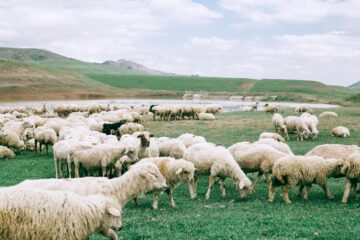Ireland is currently preparing for one of its biggest festivals – the Ploughing Championship.
The first inter-county ploughing contest was held between County Wexford and County Kildare on 16 February 1931 in a 26-acre field at Coursetown in Athy, as a result of an argument between two lifelong friends, Denis Allen of Gorey. Each argued that their respective counties had the best ploughmen.
Since then, the National Ploughing Championships has expanded to over 800 acres with 1,400 exhibitors. It has been extended beyond ploughing, farming or machinery enthusiasts and now features attractions such as live entertainment, music & dancing, craft village, live cooking demonstrations, celebrity appearances and pony games.
The original Mission Statement for the National Ploughing Association was set out to bring the message of good ploughing to all parts of the country and to provide a pleasant and friendly place to meet and do business. In 2013, the Farming Magazine Grassroots asked the question “Did NPA live up to its Mission Statement?” and concluded “There is no doubt that it has, tenfold”.
The National Ploughing Championships takes place each year in the month of September. The 2017 Championships will be held at Screggan, Tullamore, Co Offaly from September 19th – 21st 2017.
It has expanded from requiring a small field of 26 acres to needing over 700 acres of land today. Within this, the site now requires 180 acres for ploughing, 100 acres for trade stands and exhibition space, 400 acres of car parking and a demonstration area of approximately 25 acres.
Since its inception, the National Ploughing Championships has become much more than just an annual inter-county competition; it has become an intrinsic part of Irish rural life. With 300,000 visitors each year, the event in Tullamore is now six times bigger than Electric Picnic
This year, Aldi, one of the main sponsors, will have former Irish rugby captain Paul O’Connell running drills outside its tent, while 2fm DJ Jenny Greene cranks out tunes inside. The event could probably become the Electric Picnic of country and western music if the organisers wanted to push it in that direction.
From here on in, McHugh wants the focus to be on improving the quality of the experience. With the event, now in its 85th year, oscillating between harvest festival and shop window, ploughing appears to be an ever-decreasing element. “It started with ploughing and we don’t intend ever dropping the word ploughing,” organizers say.
In Hochheim, Germany, the enthusiasm for agriculture is growing as well. Last year, on September 3 and 4, the first Hocheimer ploughing festival was held. Even if the success of the festival can’t be compared to the Irish one, many people enjoyed the rare occurrence.
The festival came about after the annual showing of vintage farm equipment held in the city. Many people expressed their wish to see these machines in action. And there was a lot to see, farmers demonstrated how fields were cultivated after the Second World War without the advantages modern technology gives. What a modern tractor is able to do in hours, used to take days.
A competition was held between the owners of the vintage machines, of who could plough the straightest line with their equipment, while onlookers were cared for with food and drinks. Of course visitors were also able to ask questions about the machinery and some farmers even took them on a test ride.
Not only machines were present at the festival, a local farmer also brought out his horses Romus and Romi to demonstrate the work with a horse plough. The horses were both 20 years old during the festival, being in Firedel Dexheimers possession for 15 years, who trained them to be wood skidding horses.
Not only the adults had fun, there was plenty to do for the younger visitors. The children could play on a barefoot-path, trampoline and straw castle. The locals found the first instalment of the festival to be a success and already made plans for another one this year.
Different Asian cultures also have their equivalent to the Irish Ploughing Festival. The Royal Ploughing Ceremony is an ancient royal rite held in many Asian countries to mark the traditional beginning of the rice growing season. The royal ploughing ceremony, called Lehtun Mingala, was also practiced in pre-colonial Burma until 1885 when the monarchy was abolished.
In the various versions of Ramayana, an Indian poem, Sita, the heroine appears from the ploughed earth as a baby when Janaka, the king of Videha ploughs the field in the royal ceremony. This is the earliest historical account of this agricultural ritual. This tradition is a pan-Greater Indian agricultural ritual Thai painting.
In the ceremony, two sacred oxen are hitched to a wooden plough and they plough a furrow in some ceremonial ground, while rice seed is sown by court Brahmins. After the ploughing, the oxen are offered plates of food, including rice, corn, green beans, sesame, fresh-cut grass, water and rice whisky.
Depending on what the oxen eat, court astrologers and Brahmins make a prediction on whether the coming growing season will be bountiful or not. The ceremony is rooted in Brahman belief, and is held to ensure a good harvest. In the case of the Burmese royal ploughing ceremony, it may also have Buddhist associations. In traditional accounts of the Buddha’s life, Prince Siddhartha, as an infant, performed his first miracle during a royal ploughing ceremony, by meditating underneath a rose apple tree, thus exemplifying his precocious nature.
Burmese chronicles traditionally attribute the start of this rite to the late 500s CE during the Pagan dynasty, when it was performed by the kings Htuntaik, Htunpyit and Htunchit. However, this costly ritual did not occur annually nor was it performed by every monarch. During this ritual, the king plowed a specifically designated field outside the royal palace called the ledawgyi with white oxen that were adorned with golden and silver, followed by princes and ministers, who took turns to ceremonially plow the fields.
While the plowing was undertaken, Brahmin priests offered prayers and offerings to the 15 Hindu deities, while a group of nat votaries and votaresses invoked the 37 chief nats (indigenous spirits). The ploughing ceremony was a ritual to propitiate the rain god, Moe Khaung Kyawzwa in order to ensure a good harvest for the kingdom, and also a way for the king to present himself as a peasant king to the commoners.
In Thailand, the rite dates back to the Sukhothai Kingdom (1238–1438). During John Crawfurd’s Siam mission, he noted on 27 April 1822 (near the end of the reign of Rama II).
By Catherina Arndt



